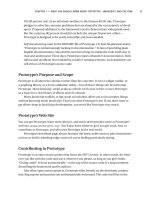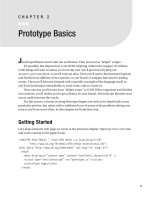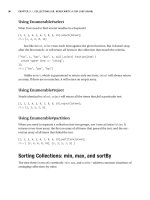Practical prototype and scipt.aculo.us part 11 pot
Bạn đang xem bản rút gọn của tài liệu. Xem và tải ngay bản đầy đủ của tài liệu tại đây (172.56 KB, 6 trang )
Notice that we’re incrementing two at a time, skipping all the odd values of i.
Now we can extend
Enumerable onto our class:
Object.extend(EvenArray.prototype, Enumerable);
Remember how Object.extend works—we’re taking each property on Enumerable and
copying it onto
EvenArray.prototype.
And we’re done. No, really. Try it out:
even.each( function(item) { console.log(item); });
//-> zero
//-> two
//-> four
even.map( function(item) { return item.toUpperCase(); });
//-> ["ZERO", "TWO", "FOUR"]
By defining one method (_each), we’re now able to use any Enumerable method on
instances of
EvenArray.
So, to review, mixing
Enumerable into your own classes is a two-step process. First,
define the
_each method. Next, copy the Enumerable methods onto your class with
Object.extend. When using Prototype, you’ll find there is rarely a step three.
Summary
Playing with Enumerable methods is a good way to dip your toe into the Prototype pool.
You’ll use them in many different contexts throughout your code. And because they’re
abstract, they’re mercifully free of the annoying cross-browser issues that cast their
shadow over nearly every other area of browser-based JavaScript development. Before
you forge ahead, make sure you’re very comfortable with everything we’ve covered in
this chapter
.
CHAPTER 3 ■ COLLECTIONS (OR, NEVER WRITE A FOR LOOP AGAIN)48
Ajax: Advanced Client/Server
Communication
By now, you’re almost certainly familiar with Ajax as a buzzword. Technically, it’s an
acronym—Asynchronous JavaScript and XML—and refers specifically to JavaScript’s
XmlHttpRequest object, which lets a browser initiate an HTTP request outside the
confines of the traditional page request.
Yawn. The technology isn’t the exciting part. Ajax is huge because it pushes the
boundaries of what you can do with a web UI: it lets you reload part of a page without
reloading the entire page. For a page-based medium like the Web, this is a seismic leap
forward.
Ajax Rocks
XmlHttpRequest (XHR for short) is a JavaScript interface for making arbitrary HTTP
requests. It lets a developer ask the browser to fetch a URL in the background, but with-
out any of the typical baggage of a page request—the hourglass, the new page, and the
re-rendering.
Think of it as an HTTP library for JavaScript, not unlike Ruby’s
Net::HTTP class or
PHP’s
libcurl bindings. But because it lives on the client side, it can act as a scout, mar-
shaling requests between client and server in a much less disruptive way than the typical
page request.
The difference is crucial—the user has to wait around for a page request, but
XHR doesn’t. Like the acronym says, Ajax allows for
asynchronous communication—
the JavaScript engine can create a request, send it off, and then do other things until the
response comes back. It’s far better than making your users do other things until
the response comes back.
49
CHAPTER 4
Ajax Sucks
It’s not all sunshine and rainbows, though. Ajax is much easier to talk about than it is
to do.
The problem that afflicts JavaScript in general applies to Ajax in particular: the
XmlHttpRequest object has its own set of bugs, inconsistencies, and other pitfalls from
browser to browser. Created by Microsoft and first released as part of Internet Explorer 5,
the XHR object gained popularity once it was implemented by the other major browser
vendors—even though there was no formal specification to describe how it ought to work.
(The W3C has since started an XHR specification, currently in “Working Draft” status.)
For this reason, it’s painful and frustrating to work with XHR without some sort of
wrapper library to smooth out the rough edges. Prototype takes the awkward, unintuitive
API of
XmlHttpRequest and builds an easy-to-use API around it.
Prototype’s Ajax Object
Let’s set up an environment to play around with Ajax. In a text editor, create a file named
ajax.js and place some JavaScript content inside. This will be the file we load with Ajax
(see Listing 4-1).
Listing 4-1. The ajax.js File
alert('pancakes!');
Create a directory for this file and save it.
■Caution Since Ajax is an HTTP request interface, these examples require a web server to communicate
with. Opening these examples straight from the local disk (using the
file: protocol) will yield mixed results.
Try running them on a local installation of Apache—or on space you control on a remote web server.
CHAPTER 4 ■ AJAX: ADVANCED CLIENT/SERVER COMMUNICATION50
Now we need a page to make the Ajax request from. Create an empty HTML page,
call it
index.html, and save it in the same directory as ajax.js. Listing 4-2 shows the
index.html file.
Listing 4-2. The index.html File
<!DOCTYPE html PUBLIC "-//W3C//DTD XHTML 1.0 Transitional//EN"
" /><html>
<head>
<meta http-equiv="Content-type" content="text/html; charset=utf-8">
<title>Blank Page</title>
<script </head>
<body>
<h1>Blank Page</h1>
</body>
</html>
Notice how we load Prototype by including it in the head of our document via a
script tag. You’ll need to place a copy of prototype.js in the same directory as index.html.
Now open
index.html in Firefox. We’ll use Firefox for these examples so that we can
execute commands on the fly in the Firebug interactive shell. Make sure the Console tab
is focused, as shown in Figure 4-1.
CHAPTER 4 ■ AJAX: ADVANCED CLIENT/SERVER COMMUNICATION 51
Figure 4-1. Firebug is open to the console tab at the bottom of the screen.
Ajax.Request
Now type the following into the shell:
new Ajax.Request('ajax.js', { method: 'get' });
You should see the dialog shown in Figure 4-2.
Figure 4-2. This dialog came from our external JavaScript file.
CHAPTER 4 ■ AJAX: ADVANCED CLIENT/SERVER COMMUNICATION52
The Ajax.Request call fetched our external file and evaluated the JavaScript we placed
inside. This simple example teaches you several things about
Ajax.Request:
• It’s called as a constructor (using the
new keyword).
• Its first argument is the name of the URL you want to load. Here it’s a relative URL
because the file we want to load is in the same directory; but you can also use an
absolute URL (one that begins with a forward slash).
■Caution Keep in mind that this URL can’t begin with http because of the same-domain policy of Ajax—
even if the URL points internally.
• Its second argument is an object that can contain any number of property/value
pairs. (We’ll call this the
options argument.) Prototype uses this convention in a
number of places as a way of approximating named arguments. In this example,
we’re specifying that the browser should make an HTTP GET request for this file.
We only need to specify this because it’s overriding a default—if you omit the
method option, Ajax.Request defaults to a POST.
• The JavaScript we placed in
ajax.js was evaluated automatically, so we know that
Ajax.Request will evaluate the response if it’s served up as JavaScript. Web servers
typically give JS files a MIME type of
text/javascript or application/x-javascript;
Prototype knows to treat those types (and a handful of others) as JavaScript.
Now let’s add to this example. Type the same line as before, but with an extra prop-
erty in the
options argument:
new Ajax.Request('ajax.js', { method: 'get',
onComplete: function() { alert('complete'); }
});
■Tip You can switch the Firebug console to multiline input by clicking the button at the far right of the
command line.
CHAPTER 4 ■ AJAX: ADVANCED CLIENT/SERVER COMMUNICATION 53









